Marathon Hackathon win!
Next Tech Lab continue with the winning streak
SRM University AP, Andhra Pradesh equips students to combat adversities and continue to achieve accolades by nurturing their talent and offering them an impetus for growth. Abbas, a third-year CSE student, wins yet another Hackathon at Berkeley. While on his semester abroad program at the University of California, Berkeley, he participated in Hacktech which is Caltech’s premier intercollegiate hackathon. Along with three other team members from Georgia Tech, Virginia Tech, and USC, Abbas competed against 450 hackers who identify and build innovative, technological solutions to solve problems in a variety of disciplines. The team was a finalist in the “Best Overall Hack” and won “Best Hack That Gives People a Voice” by Facebook.
Focusing on “Giving People a Voice”, sponsored by Facebook, Abbas, and team coordinated through Git and voice messaging platforms like Discord and Slack as the Hackathon turned into a virtual competition with the unfortunate outbreak of COVID-19.
SRM AP’s Next Tech Lab team have developed MeetMe, that provides a platform to interact with various people across the globe, irrespective of their background. “MeetMe is a platform that is designed to take the user out of their comfort zone and have them meet people quite different from themselves.”, explains Abbas.
When asked about the intention behind developing such an application, Abbas says, “When pandemics like Coronavirus hit, despite millions being fatally impacted, most people face challenges like Xenophobia causing added fear and damage. We felt that we should do our part to help make the world a better place using technology. We came across UNICEF’s 5 things to do to fight xenophobia. It primarily suggests that connecting people across cultural backgrounds can eliminate prejudices against a certain group, community, or race. Hence, we developed MeetMe.”
The team believes, “MeetMe will encourage people to interact with groups that they are unfamiliar with, which helps them to understand their cultures better, leading to communal harmony and mutual understanding. This could be particularly useful in the wake of catastrophes such as Coronavirus that unfortunately cause incorrect opinions pertaining to certain groups. By providing a platform for these in-person gatherings, we are trying to ensure that the attendees get the chance to interact with people from marginalized communities and reduce undesired emotions that they may harbor consciously or unconsciously towards them.”
- Published in News
Smart Coating Materials to Reduce Thermal Heat Wave
Cost-effective solution to Global Warming
Renowned publishing house Elsevier is publishing Energy Saving Coating Materials-Design, Process, Implementation and Recent Developments (1st Edition), a book edited by Dr Goutam Kumar Dalapati, Associate Professor, Department of Physics, SRM University- AP and Dr Mohit Sharma, Scientist, A*STAR (Agency for Science, Technology and Research), Singapore. The book is about their collaborative research on Thermal Management with the application of coating materials.

Dr Dalapati, Editor of the book
Countries in tropical and temperate belts such as India, Australia, Middle Eastern and African countries receive most of the sunlight. The heat generation is naturally high in these countries. Studies show that the usage of air-conditioner is also very high in these countries to maintain the desired comfort in both home and office spaces. “Air-conditioners need a huge amount of electricity to be operational. Statistics says, globally, out of hundred units of electricity, almost 35-40 units are used for air-conditioning for either heating or cooling purposes. It also has other drawbacks as it generates air-pollutants which aid in global warming. Our Study in the lab of A*STAR shows that even a one-degree change in the air-conditioner’s temperature settings can save a significant amount of electricity. In our study, we have focused on ways of passive cooling, i.e. how the indoor comfort can be maintained without electricity.” Dr Dalapati said.
Dr Dalapati’s book is about developing new materials and process which can effectively reduce temperature inside the buildings. With a vision of having zero-emission buildings in the future, this book focuses on materials, interactions of these materials with sunlight, and then how these materials can be used productively to reduce the temperature in a building, minimising the thermal budget. His team has proposed different type of materials along with different type of techniques. One of those innovative techniques is, Solar Smart Film, which he has a patent for. When applied on the glass, Solar Smart Film is an effective coating material to block the infra-red radiation, which causes the heat, and it allows the visible light only. When applied on concrete, the coating (cool paint) reduces the heat there too. This smart film can reduce the increment of temperature from 2 to 10 degrees centigrade. The usual product available in the market is silver based, hence highly priced. Dr Dalapati’s team has replaced silver-based products with alternative materials like copper or copper-like materials which are cheap in cost, environmentally stable, non-toxic and can be found easily. The process to develop low cost solar films is also explained in his book.
When asked how the idea of publishing a book came to his mind, Dr Dalapati replied, “At first, we published a 100-page article on a similar topic in Progress in Materials Science, a reputed International Review Journal with an Impact Factor of 23.72. Later we thought of publishing a book because whereas an article’s reach is limited within the researchers only, through a book many more people will come to know about our research and its impact on the well-being of the society. It will help in creating a general awareness among common people as well as young minds like high school and college students will be provided with opportunities for brain-storming.”
Dr Dalapati is currently busy in making his product commercially available. He is also developing apparatus for human applications, which will protect the body from thermal heat waves in summer. A patent application has been filed to the Government of India in this regard. In the Future, he also plans to publish further editions of this book where more complex problems will be discussed.
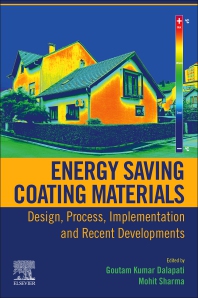
Cover Page of the Book
DETAILS OF THE BOOK:
Book Title: Energy Saving Coating Materials-Design, Process,
Implementation and Recent Developments (1st Edition)
Editors: Goutam Kumar Dalapati and Mohit Sharma
Paperback ISBN: 9780128221037
Publishing House: Elsevier
Published Date: 1st June 2020
Page Count: 368
Language: English
Copyright: © Elsevier 2020
- Published in News
Students showed their mettle at Sports Meet, brought home trophies!
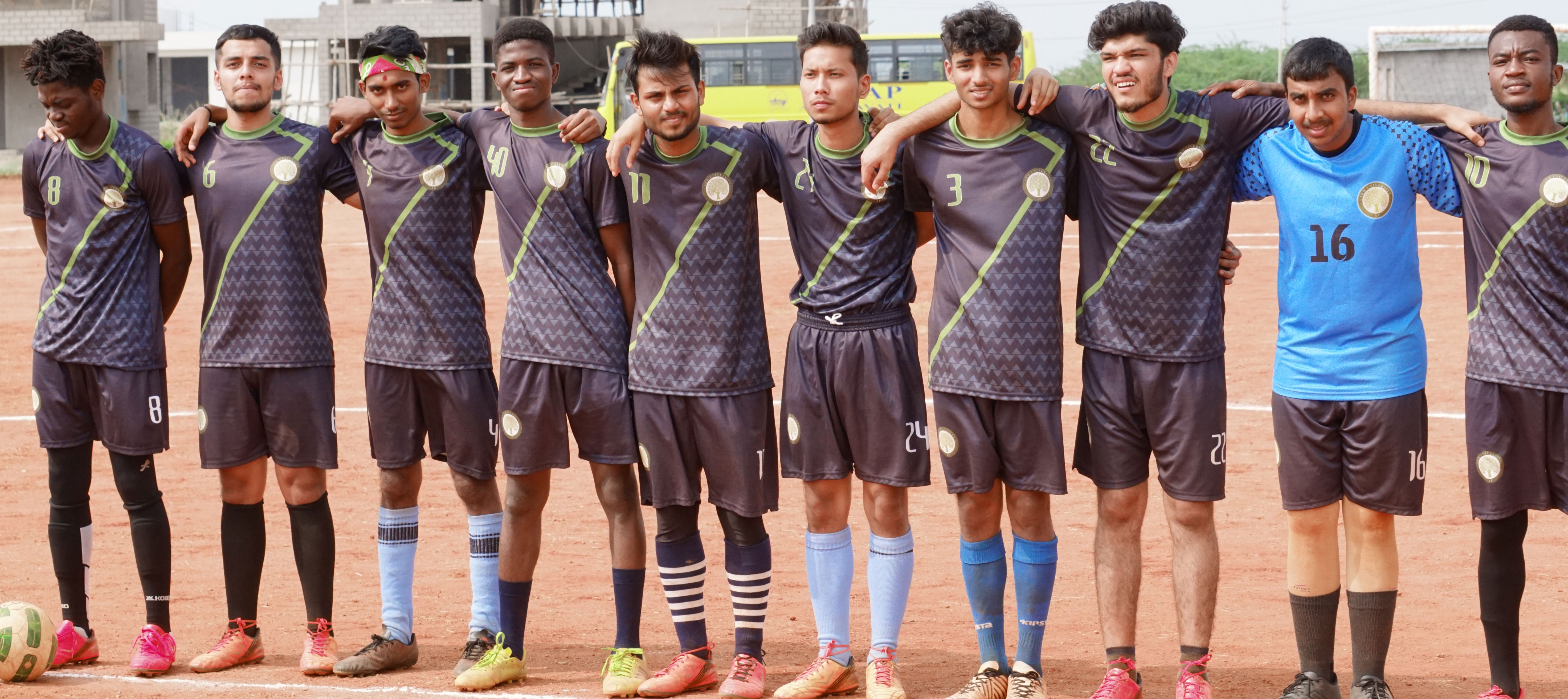
Football Team of SRM University-AP
There is a famous saying “All work and no play makes Jack a dull boy.” Therefore, here at SRM University-AP, students are always encouraged to go beyond the limits of curricular activities. The Students of SRM-AP have proven to be all-rounders by winning several cups in various segments of different Inter-College Sports Meet. VIT-AP and MVR College of Engineering and Technology have recently organised the Inter College Sports in their respective campuses. Students of SRM-AP merrily participated and successfully bagged winner’s trophy in football and cricket and the runner-up trophy in lawn tennis in Vitopia, Sports Tournament of VIT-AP. They have also secured the winner’s trophy in cricket, and the runner-up trophy in badminton in the Inter-college Sports Championship organised by MVR College of Engineering and Technology.
The football team of SRM-AP was invincible. Their incredible performance throughout the tournament took them straight to the finals where they thrashed VIT-AP, another finalist with a straight 3-0, a resounding victory without any doubt. SRM University-AP team’s captain Ishmael, a 3rd-year Mechanical Engineering student, was able to lead the team successfully. He also turned out to be an ideal strategist. Andrew, another 3rd-year Mechanical Engineering student, sent the ball into the net twice during the match, whereas Venky, 1st-year Computer science and engineering student, supported his team by scoring another goal.

Aiming to Score
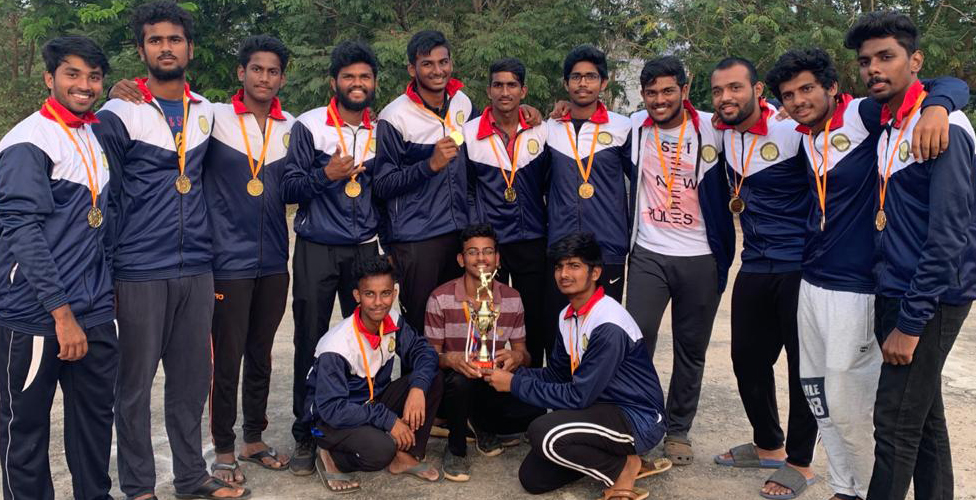
Cricket Team with the Trophy
Our cricket team has proven their talent by winning two consecutive champion’s trophy both in VITOPIA and MVR Sports Meet. Jaswanth, a 3rd-year Electronics and Communication Engineering student and the captain of the cricket team, says, “our team has some up-and-coming players. However, at the end of the day, it is the team effort that leads us to success.”
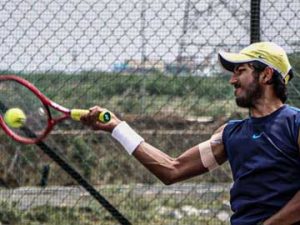
GKV Manikantha hitting the ball
Lawn tennis is another game of hardcore physical strength mixed with ingenious strategies. GKV Manikantha, 1st-year Mechanical Engineering student and a passionate player, won the runner-up trophy at VITOPIA, yet it could not make him happy. He said, “Due to my injury, I could not put up a fight in the finals. I was hurt and therefore had to retire from the game. I am trying to have a speedy recovery and will be back very soon.”
Twelve teams from different colleges participated in the badminton tournament. RK College OF Engineering, Velagapudi Ramakrishna Siddhartha Engineering College, DVR & Dr HS MIC College of Technology, GDMM College of Engineering & Technology were a few among them. Though our team could not secure the first prize, Rathan, a 2nd year CSE student, put up a marvellous fight which brought the university the runner-up trophy.
- Published in News
Pathbreaking research in genetics potent to cure disorders
Dr. Sutharsan Govindarajan receives prestigious INSPIRE Faculty award
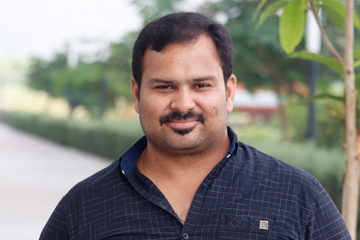 Department of Science and Technology, Government of India has awarded Dr. Sutharsan Govindarajan, Assistant Professor, Department of Biological Sciences, SRM University-AP, the prestigious fellowship “Innovation in Science Pursuit for Inspired Research (INSPIRE)”. This initiative provides funds and a platform to potent young achievers for conducting independent research and strengthening the Science & Technology base. Dr. Sutharsan is to receive a total research grant of 35 lakhs for a period of 5 years as a DST-INSPIRE fellow.
Department of Science and Technology, Government of India has awarded Dr. Sutharsan Govindarajan, Assistant Professor, Department of Biological Sciences, SRM University-AP, the prestigious fellowship “Innovation in Science Pursuit for Inspired Research (INSPIRE)”. This initiative provides funds and a platform to potent young achievers for conducting independent research and strengthening the Science & Technology base. Dr. Sutharsan is to receive a total research grant of 35 lakhs for a period of 5 years as a DST-INSPIRE fellow.
Dr. Sutharsan will establish an independent research lab at SRM University, AP, Andhra Pradesh to focus on CRISPR-Cas biology. “CRISPR technology is a powerful tool for editing genomes. It is capable of changing a single base of DNA out of billions of bases. This invention is potent to cure genetic disorders, enunciating its candidature to receive the Nobel Prize in the future.”, informs Dr. Sutharsan.
Dr. Sutharsan’s research work has the potential to nullify the single limitation of the CRISPR technology- ‘off-target’ effects i.e., unintended base changes that affects the accuracy of DNA editing. Through his research titled “Discovery of novel CRISPR-Cas silencing proteins”, he and his team intend to prevent ‘off-targets’ by identifying and characterizing the novel anti-CRISPR proteins that can inhibit in CRISPR-Cas proteins. Dr, Sutharsan believes, “This will improve the efficiency of CRISPR technology which will be highly useful for gene editing technologies, alleviating a wide range of genetic disorders and diseases in the future”.
- Published in News

